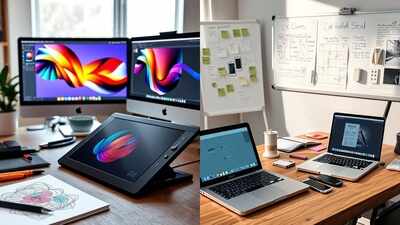ARTICLE AD BOX

UX Designer vs. Graphic Designer: Which career suits you more?
In a world where digital experiences shape how we live, work, and play, design careers are more important than ever. Among the most sought-after creative roles today are UX Designers and Graphic Designers.
While both careers deal with design and aesthetics, they follow different approaches, tools, and objectives. So, if you're torn between creating beautiful visuals and crafting seamless user journeys, this comparison might help you decide.
Core focus: Visual impact vs user interaction
At the heart of the difference lies purpose. A Graphic Designer is primarily concerned with how things look. Their job is to communicate ideas through visuals—logos, posters, brochures, ads, and social media creatives.
They combine typography, colour theory, and layout design to create impactful imagery.A UX Designer (User Experience Designer), however, is more focused on how things work. Their goal is to design digital products—like websites and mobile apps—that are easy, intuitive, and enjoyable to use. They think about the flow, user behaviour, and pain points, often asking, “How can this be made simpler for the user?”
Tools and techniques
Graphic designers mostly work with visual design software like Adobe Photoshop, Illustrator, and InDesign.
Their creations are often static and finalised after rounds of feedback. They work on brand identity, advertising material, packaging, and digital content.UX designers, on the other hand, use tools like Figma, Sketch, Adobe XD, and InVision to build wireframes and interactive prototypes. Their workflow includes user research, usability testing, and sometimes even collaboration with developers. Their output is usually dynamic, evolving based on how real users interact with the design.
Work environment and collaboration
A Graphic Designer may work in advertising agencies, print and publishing companies, corporate marketing departments, or as freelancers. Their work is typically more individual, though they often coordinate with copywriters and brand managers.UX Designers usually work in product teams, especially in tech companies, startups, or digital design agencies. Their work is highly collaborative—they interact with product managers, developers, marketers, and even customers.
The role requires a mix of creativity and strategy, with a strong user-centric mindset.
Career path and required skills
Graphic design is a field that welcomes those with an eye for colour, typography, and visual harmony. A degree in graphic design, visual communication, or fine arts can help, though a strong portfolio is often the key.UX design is more interdisciplinary. Successful UX designers often come from backgrounds in psychology, human-computer interaction, design, or even engineering.
They need strong analytical thinking, empathy, and problem-solving skills alongside their design ability.
Growth potential
Both careers offer strong growth potential, but the demand for UX Designers has risen sharply in recent years due to the rapid expansion of digital platforms. As companies increasingly prioritise user-centric design for their apps, websites, and digital services, UX roles have become more prominent and often offer quicker career advancement.Graphic Design continues to be a vital profession, especially in industries like advertising, media, and branding. However, growth in this field tends to be steadier and may depend more on industry demand, portfolio strength, and specialisation.Globally, UX design has gained more traction in tech-driven markets, with higher visibility in regions like North America and Europe. Overall, both fields offer rewarding opportunities—UX for those leaning toward product and user strategy, and graphic design for those passionate about visual storytelling and brand identity.If you're passionate about creating striking visuals and love working with branding and layout, graphic design could be your calling. But if you're curious about user behaviour, enjoy solving problems, and want to shape how people interact with digital products, UX design might be the better fit.
In the end, both roles are crucial in today’s design ecosystem. One designs for the eye, the other for the experience—and often, the best products combine the strengths of both.



.png)
.png)
.png)
















 2 hours ago
5
2 hours ago
5









 English (US) ·
English (US) ·